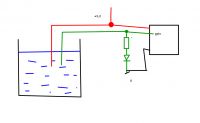Hey,
in ESP01 I have a status check on GPIO2. When I connect GND, it shows 1, when I disconnect it shows 0.
I have a circuit for this (shared VCC and GND with the one from ESP) with a physical switch and LED.
I would like to check if this additional circuit is closed, but there is 3.3v on it, not GND.
How to connect one to the other? Some transistor between GND and GPIO2, with the middle leg to my circuit? Just which one? I'm completely green in these matters :/.
in ESP01 I have a status check on GPIO2. When I connect GND, it shows 1, when I disconnect it shows 0.
I have a circuit for this (shared VCC and GND with the one from ESP) with a physical switch and LED.
I would like to check if this additional circuit is closed, but there is 3.3v on it, not GND.
How to connect one to the other? Some transistor between GND and GPIO2, with the middle leg to my circuit? Just which one? I'm completely green in these matters :/.









